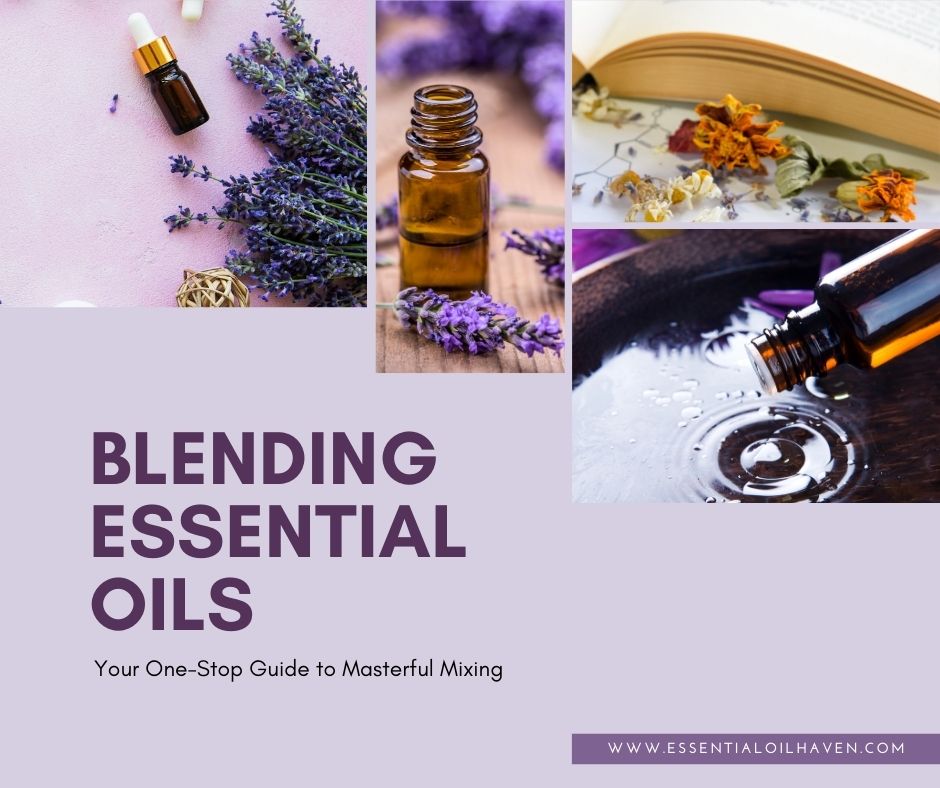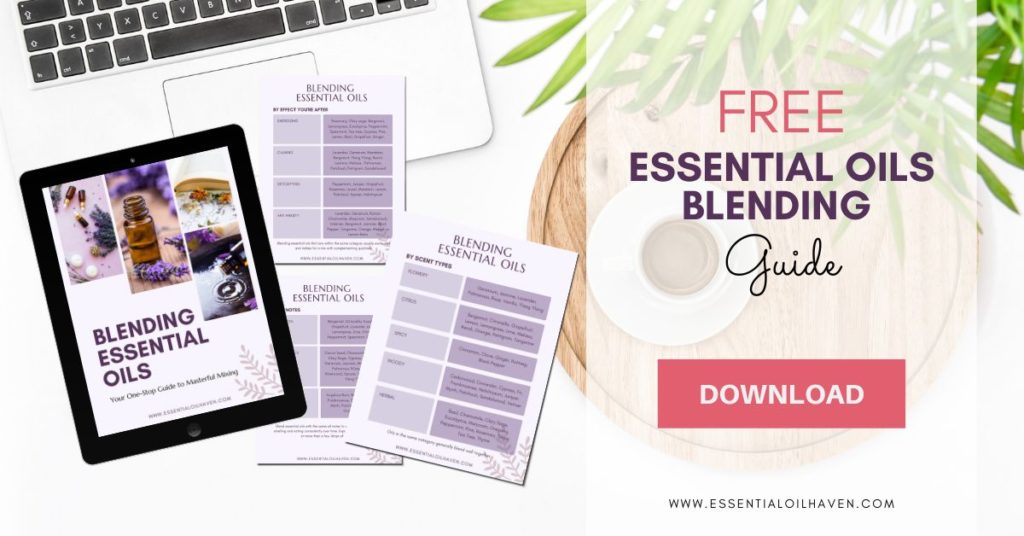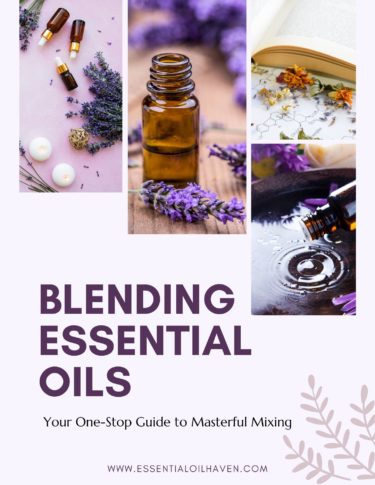 As I’m starting out, I’m thinking blending essential oils is quite intimidating! How do I know how much to use of each oil? Which oils go together? What effect will the combined oils have? Will they complement each other and really make my aromatherapy recipes work?
As I’m starting out, I’m thinking blending essential oils is quite intimidating! How do I know how much to use of each oil? Which oils go together? What effect will the combined oils have? Will they complement each other and really make my aromatherapy recipes work?
What I know so far, is that blending essential oils is definitely part art, and part science.
Why Blend Essential Oils?
Essential oils are dynamic organic liquids that work in synergy with each other. Synergy means ‘working together in harmony’.
This post contains affiliate links, which means if you make a purchase through these links, I may receive a small commission at no extra cost to you. Read my full disclosure policy here.
In general, essential oils work better when mixed with other essential oils. Each essential oil has a multitude of compounds, and while we come to know them for their beneficial, healing properties, each oil also has weaker components that may even trigger adverse reactions in some people.
When blending essential oils, one oil can balance out the weaker parts of another, and even negate the possible side effects that oil could have if applied on its own.
Aromatherapy is a highly individual experience, so when I say ‘side effects’, please don’t get scared. One person may simply react differently to an oil than another. I’m sure you’ve seen this when you’ve tried to have your husband or best friend sniff your latest essential oils purchase, only for them to wrinkle their nose at it and politely decline further interaction with said bottle.
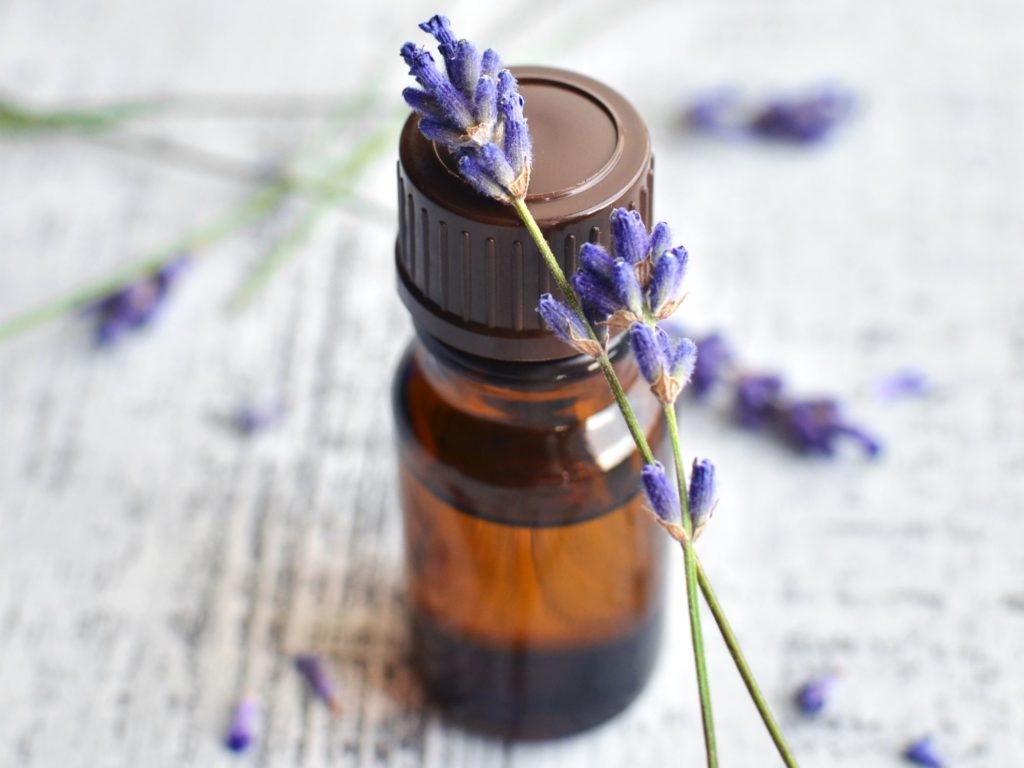
Lavender is a popular oil in many blends.
Another example is Lavender. Many people love it, but a lot of people also quite dislike it on its own. Most essential oil sleep blends contain Lavender, and as soon as its blended in with other oils, this synergy tends to be tolerated much wider across the board.
Group Your Essential Oils
Before beginning to create your own aromatherapy recipes of any sort, a good starting point is to categorize your essential oils into groups that share similar traits. This can be by what they do (effects you’re after), how they smell (scent type), or if you want to be really technical, you’ll sort them by their chemical make-up of how fast each of them evaporates (notes).
In aromatherapy, mixtures of between two to five oils are most commonly used for blending, as that seems to be the ‘sweet spot’ of achieving the most synergy between the oils.
The success of your blend will not only depend on simply mixing a few oils together, but also on which oils you choose to combine and for what purpose.
By Effect
Grouping essential oils by the type of effects they have actually makes the most sense to me; I find it the easiest to grasp.
Create yourself a reference on which oils are classified for example as energizing, calming, or any other state of mind or health you are trying to address.
To get you started, here is a list of most popular oils and their properties:
| Essential Oils by Effect You’re After | |
| Energizing | Rosemary, Clary sage, Bergamot, Lemongrass, Eucalyptus, Peppermint, Spearmint, Tea tree, Cypress, Pine, Lemon, Basil, Grapefruit, Ginger |
| Calming | Lavender, Geranium, Mandarin, Bergamot, Ylang Ylang, Neroli, Jasmine, Melissa , Palmarosa, Patchouli, Petitgrain, Sandalwood |
| Detoxifying | Peppermint, Juniper, Grapefruit, Rosemary, Laurel, Mandarin, Lemon, Patchouli, Hyssop, Helichrysum |
| Anti-anxiety | Lavender, Geranium, Roman Chamomile, Marjoram, Sandalwood, Valerian, Bergamot, Jasmine, Black Pepper, Tangerine, Orange, Melissa or Lemon Balm |
Blending essential oils that are within the same category usually works well and makes for a mix with complementing qualities.
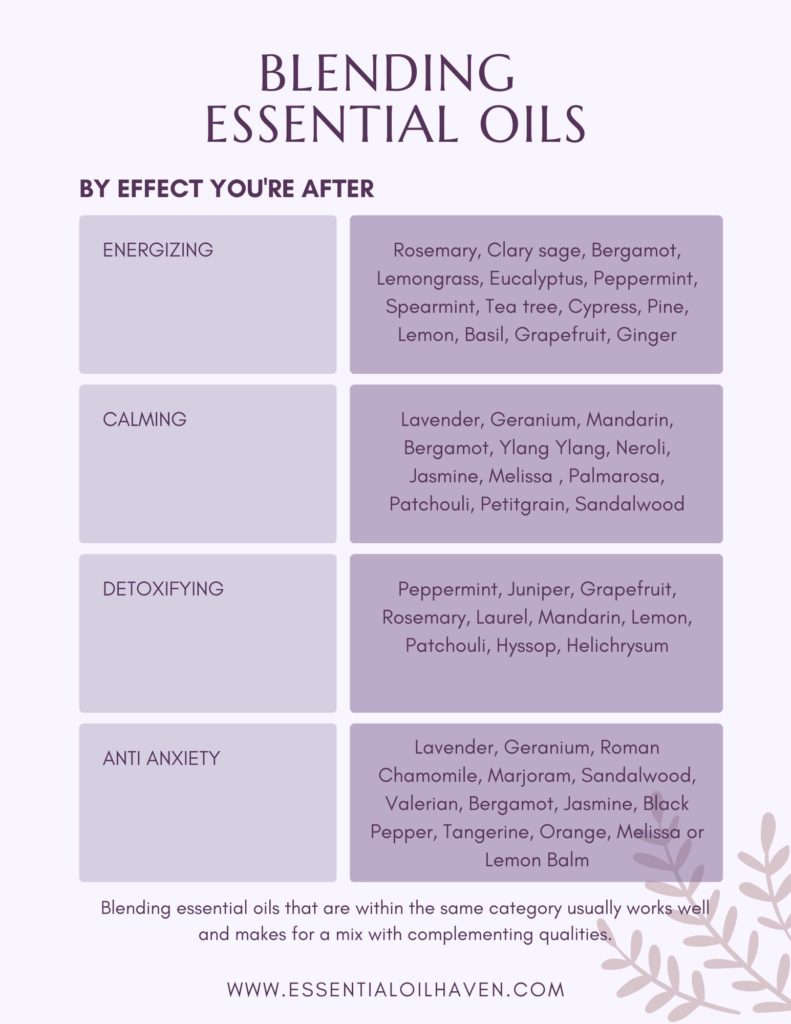
By Scent Types
You can also group your essential oils into categories of similar smelling scent types.
Some oils could certainly fit into more than one category depending on how your nose “reads” that particular scent. There is no right or wrong, just create this chart as it feels right to you and use it as a base inspiration to start blending essential oils.
A quick guide to get you started with popular oil scent types:
| Essential Oils by Scent Types | |
| Flowery | Geranium, Jasmine, Lavender, Palmarosa, Rose, Vanilla, Ylang Ylang |
| Citrus | Bergamot, Citronella, Grapefruit, Lemon, Lemongrass, Lime, Melissa, Neroli, Orange, Petitgrain, Tangerine |
| Spicy | Cinnamon, Clove, Ginger, Nutmeg, Pepper |
| Woody | Cedarwood, Coriander, Cypress, Fir, Frankincense, Helichrysum, Juniper, Myrrh, Patchouli, Sandalwood, Vetiver |
| Herbal | Basil, Chamomile, Clary Sage, Eucalyptus, Marjoram, Oregano, Peppermint, Pine, Rosemary, Sage, Tea Tree, Thyme |
Oils in the same category generally blend well together.
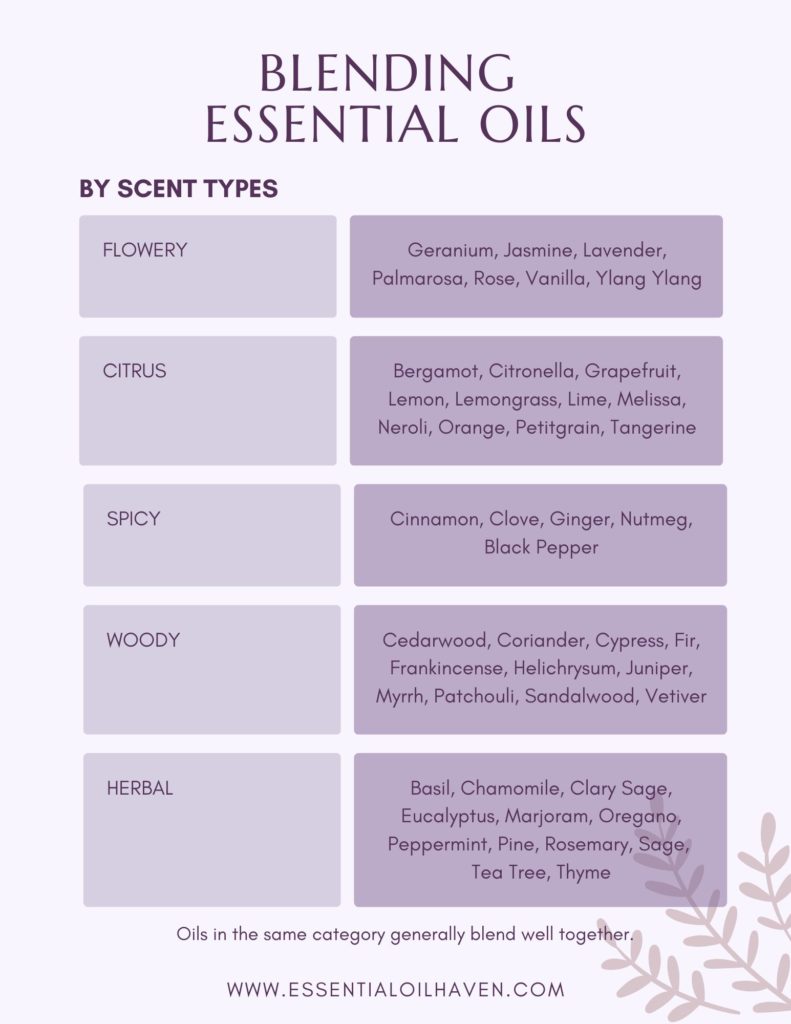
By Essential Oil Notes
Have you ever noticed that your essential oil blend smells differently after a few hours than when you first created it? This is because certain essential oils evaporate quicker than others, so while one oil might still hold its fragrance in the blend, the others may have long gone.
Similar to a musical scale, essential oils that are quickest to evaporate (usually within 1-2 hours), are called “top notes”. Next are the oils that evaporate within 2-4 hours, those are considered “middle notes”. The “base notes” are the oils that evaporate the slowest. Some base note oils can take several days to evaporate.
Here are a few examples of popular oils, divided into their oil notes:
| Essential Oils by Oil Notes | |
| Top notes | Bergamot, Citronella, Eucalyptus, Grapefruit, Lavender, Lemon, Lemongrass, Lime, Orangge, Peppermint, Spearmint, Tangerine |
| Middle notes | Carrot Seed, Chamomile, Cinnamon, Clary Sage, Cypress, Dill, Fennel, Geranium, Jasmine, Marjoram, Neroli, Palmarosa, Rose, Rosemary, Rosewood, Spruce, Tea Tree, Thyme, Ylang Ylang |
| Base notes | Angelica Root, Balsam, Cedarwood, Frankincense, Ginger, Helichrysum, Myrrh, Patchouli, Sandalwood, Vanilla, Vetiver |
Blend essential oils with the same oil notes to ensure a blend that keeps smelling and acting consistently over time. Especially if you make a batch, or more than a few drops of a diffuser, blend to your liking for your particular home use.
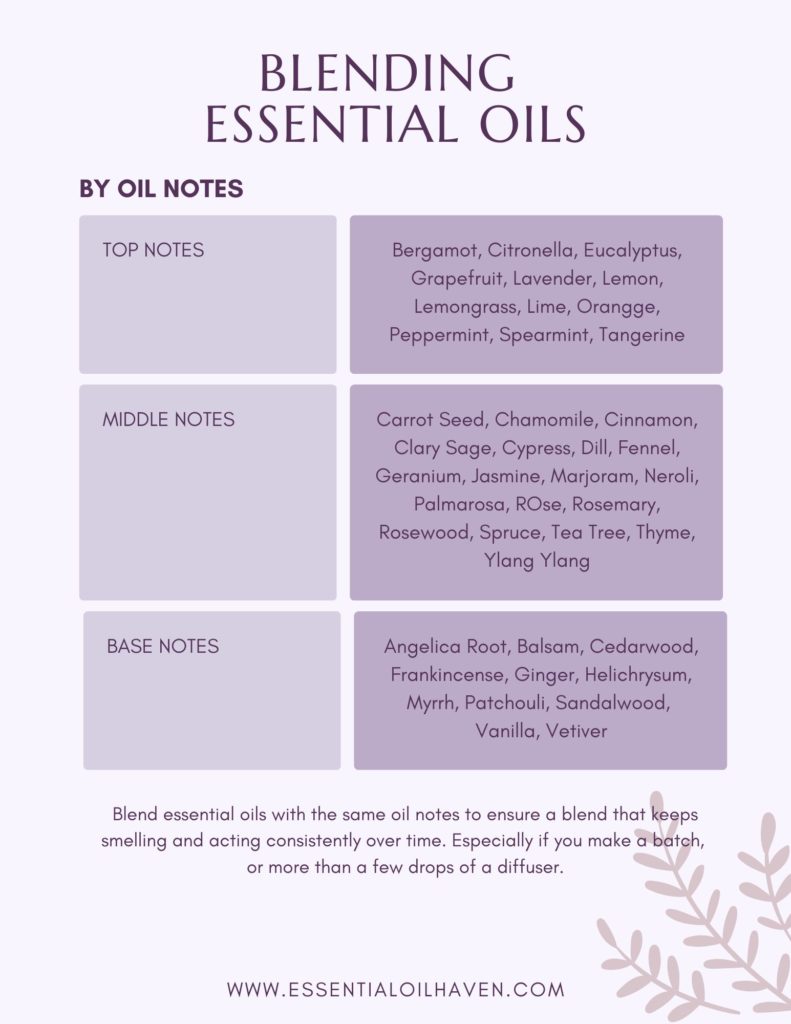
Start Blending Essential Oils at Home
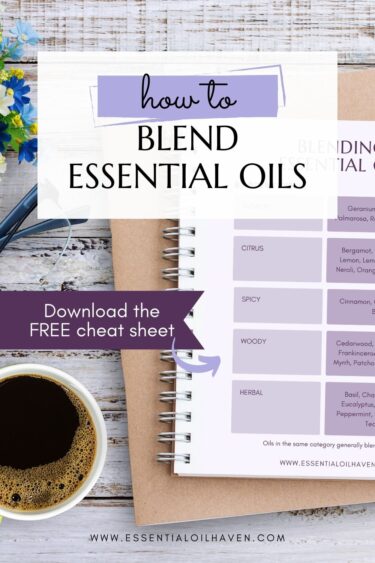
Now that you’ve read the three ways to group essential oil types together, basically you’re free to let your inner artist shine!
With a clear grouping system like this as a base, you can then also choose an essential oil from one category and blend it with an oil from another category. Rather than staying in the same group, this would then allow you to reach combined effects and a “best of both worlds” type of scenario.
I’m not sure that there are dead-set, how-to-do-this-right rules on which oils go well together, I do think there’s a level of creative freedom to your experiments.
In general though, I’m learning that for example, citrus oils go well with spicy oils. Citrus and flowery also often blend well together. Woody and flowery usually works well, and herbal and citrus are usually a good combination, too. Find your own favorites!
My Secret Tip for Mixing Essential Oils
If you’re like me, you might feel a little bit overwhelmed after trying to sort your way through all of the essential oil blending tactics and techniques available. It is a lot of information! So, one of my most favorite things to do when I’m wondering how I should mix my essential oils together, is that I head over to Amazon, search for a type of blend that I’m after, and then read the ingredient list of essential oils to see which ones have been mixed together by the professionals.
As an example, a popular relaxing blend is ‘Tranquil’ by Plant Therapy. Its ingredient list is as follows: Pink Grapefruit, Blood Orange, Patchouli, Bergamot, and Ylang Ylang. If you own any or all of these single essential oils in your collection, it’s a pretty safe bet that they go well together. Why else would the pros mix up a tincture of this combination?
Of course, this simple approach does not give you the exact measurements of how much of each oil to use in your blend. Start with a 1:1 ratio of the same amount of drops for each oil, and adjust from there. This way, you can make this blend 100% fitting to your nose buds and your individual body’s preferences.
Sleek trick, but it works for me!!! Let me know in the comments below if you’ve also successfully tried this!
Simple Essential Oil Blending Formula
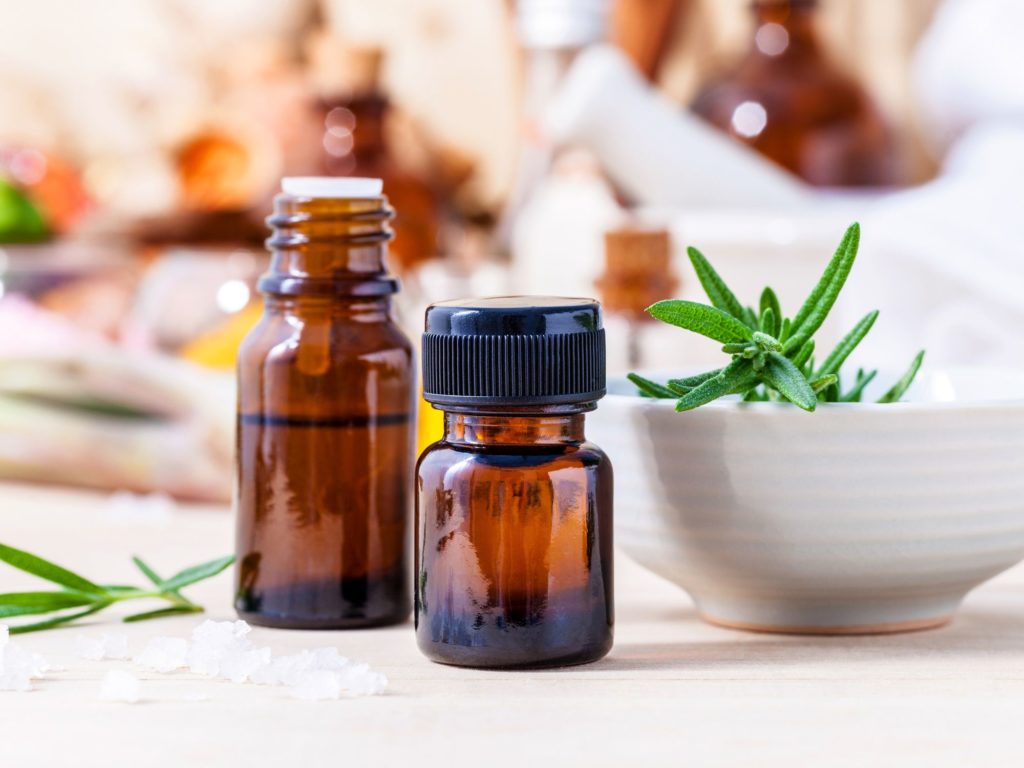
Mix your custom essential oils blend in a 15ml amber glass bottle.
To start, I recommend you use 15 mL amber glass bottles to try out your essential oil blending recipes at home. This is about the amount for one full-body massage, so even if the blend isn’t perfect, you’re not wasting a large amount of oils.
Follow this simple formula:
- Fill your 15 mL amber glass bottle almost to the top with your choice of carrier oil.
- Select 3-5 oils you’ll be using for your blend.
- For a safe dilution rate between 2.5% – 3%, you can use up to 8 drops of your oils.
- Start with one drop of each oil and see how it smells.
- Adjust from there, adding one drop at a time, until you’ve reached 8 drops total.
Blending Pre-made Blends (Synergies)
If you’re hoping to mix together two already mixed blends, I recommend you stay away from this.
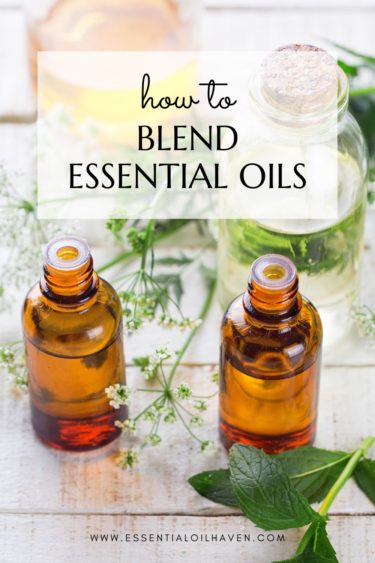
Synergies have already been made by experts to achieve a certain thing – if you want to alter this, I recommend just starting from scratch and mixing single oils.
Since synergies have been pre-made, the exact quantities of what oils have been used can only be guessed, and outcomes are therefore quite unpredictable. Trying to add or alter blends may become more frustrating than satisfactory for you. But you can always read the list of ingredients from a blend you like – and then get those as single oils, plus add in whatever other oil you’d like to blend into the mix – this will then totally make it your own!
Brand Quality
Now, as with everything in life, it is imperative that you choose good-quality essential oil brand products for your aromatherapy recipes and oil blending experiments. Depending on what you use your essential oil blend for, you can get away with different grades of oils.
Almost all oils are for external use only, but there are a few brands that can be used internally. Please read this blog post here on which essential oils are safe to ingest. Some brands are therapeutic grade essential oils (pure essential oils), while others are not and contain fillers or additives. Some brands also offer an organic line to their oils, where you can specifically shop for organically sourced oils. Mountain Rose Herbs I know for sure has organic oils in their line-up, as does Plant Therapy and Rocky Mountain Oils.
A few popular brands of essential oils that fit a variety of needs and budgets are:
- Young Living
- doTERRA
- Plant Therapy Essential Oils
- Rocky Mountain Oils
- Mountain Rose Herbs
- Edens Garden
- Aura Cacia
- REVIVE
- NOW Oils
You can read more about these companies in my easy side-by-side comparison chart, part of my best essential oil brands page.
Essential Oil Safety
As essential oils are highly concentrated and some individuals and skin types may have allergic reactions to them. Ensure you carefully read the safety labels and instructions for the particular type of product you choose.
What if I Get it Wrong?
As with any other creative expression, nobody is going to get hurt if you use a drop or two more of one oil in relation to another. You just may not get your desired result 100%; but then this also depends as to what application you’re creating your aromatherapy blend for. If it’s for mosquito repellent, well, I wouldn’t be so concerned. On the other hand, if you’re trying to get a blend right to support your healing practice, I might be a bit more alert as to how, when and why I mix these essences together.
If you now think that blending essential oils is a little bit too complicated, you may of course also explore simply buying professionally pre-made essential oil blends, and using them out-of-the box. Just be aware that with pre-made essential oil blends, you shouldn’t use those to continue further mixing and blending them.
Further Reading
This article on aromatic blending of essential oils on AromaWeb seriously explains the concept of “notes” of essential oils the absolute best. Check it out on their website.
Comments are welcome!
Do you have your own experience to share about blending essential oils? Do you have a diffuser blend that you absolutely love? Share with me and our online community in the comments below.


